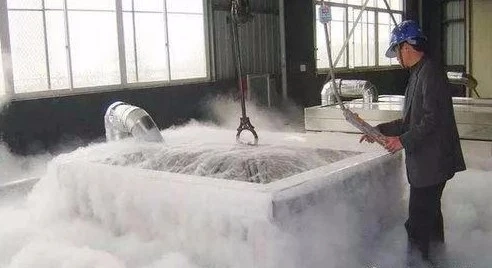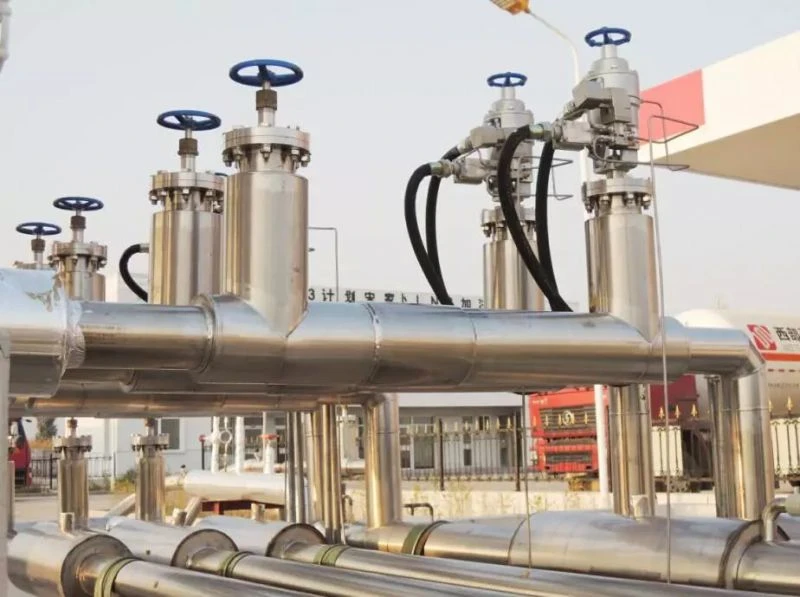Installation requirements for cryogenic valves
Because of the special structure of the cryogenic valve, the installation of the cryogenic valve also has its special requirements. Because of the long neck bonnet structure of the cryogenic valve, the valve stem must be oriented at a vertical angle of 45 degrees during installation and should be avoided on vertical lines. Otherwise, the cryogenic medium will fill the lengthened portion of the bonnet, causing the valve packing to fail and imparting a cooling amount to the valve handle, causing personal injury to the operator. For low temperature valves with pressure relief structure, pay special attention to the pressure relief direction of the valve when installing the valve. The direction of valve pressure relief should be marked on the process flow chart and reflected in the pipe axis drawing (this is extremely important). If it is necessary to set the pressure relief hole and not set, after the valve is closed, the liquid in the valve chamber will be heated and vaporized, which easily causes the valve body to burst. If the direction of pressure relief is wrong, it may vent the flammable or toxic process medium to the operation and maintenance side, causing casualties!
Cryogenic valve manufacturing
Strict manufacturing processes and special equipment are applied to the production of cryogenic valves; strict quality control is applied to the processing of parts. After special low temperature treatment, the roughed parts are placed in the cooling medium for several hours (2-6 hours) to release the stress, ensure the low temperature performance of the material, and ensure the finishing size, in order to prevent the valve from leaking due to temperature changes during low temperature conditions. The assembly of the valve is different from that of the ordinary valve. The parts are subjected to strict cleaning to remove any oil to ensure the performance.
Cryogenic valve inspection
In addition to the normal temperature and low temperature test, the low temperature valve should also be tested as follows.
1. The main parts of the ultra-low temperature valve should be subjected to cryogenic treatment (the following picture shows the cryogenic treatment of the valve).

2. The main parts and welds should be tested for low temperature impact to ensure that the valve is not brittle at low temperature conditions;
3. The valve must be tested at room temperature, first 1.5 times the nominal pressure hydraulic strength test, and then 1.1 times the nominal pressure seal test;
4. After the water pressure test, the valve must be cleaned of moisture, free of grease and kept dry;
5. Each batch of cryogenic valves shall be sampled at a certain proportion for low temperature test. The low temperature test shall be carried out after 1.5 times of hydraulic strength test;
6. After the valve is tested at low temperature, air should be prevented from entering the valve;
7. After the valve is tested at low temperature, it should be heated naturally or blown with a fan. It is forbidden to accelerate the temperature of the valve by heating or other methods.
8. After the valve low temperature test and the valve is naturally warmed up, tighten the valve fasteners again;
9. When the valve is in storage, be sure to check the valve switch to ensure that the valve is in a reasonable state;
10. During the storage and transportation of the valve, it should be noted that the stainless steel is separated from the carbon steel valve, and it is dustproof, waterproof, oilproof and bump resistant;
11. The flow direction of the valve, the pressure relief direction and the nameplate shall be inspected according to the requirements of the design unit.

Because of the special structure of the cryogenic valve, the installation of the cryogenic valve also has its special requirements. Because of the long neck bonnet structure of the cryogenic valve, the valve stem must be oriented at a vertical angle of 45 degrees during installation and should be avoided on vertical lines. Otherwise, the cryogenic medium will fill the lengthened portion of the bonnet, causing the valve packing to fail and imparting a cooling amount to the valve handle, causing personal injury to the operator. For low temperature valves with pressure relief structure, pay special attention to the pressure relief direction of the valve when installing the valve. The direction of valve pressure relief should be marked on the process flow chart and reflected in the pipe axis drawing (this is extremely important). If it is necessary to set the pressure relief hole and not set, after the valve is closed, the liquid in the valve chamber will be heated and vaporized, which easily causes the valve body to burst. If the direction of pressure relief is wrong, it may vent the flammable or toxic process medium to the operation and maintenance side, causing casualties!
Cryogenic valve manufacturing
Strict manufacturing processes and special equipment are applied to the production of cryogenic valves; strict quality control is applied to the processing of parts. After special low temperature treatment, the roughed parts are placed in the cooling medium for several hours (2-6 hours) to release the stress, ensure the low temperature performance of the material, and ensure the finishing size, in order to prevent the valve from leaking due to temperature changes during low temperature conditions. The assembly of the valve is different from that of the ordinary valve. The parts are subjected to strict cleaning to remove any oil to ensure the performance.
Cryogenic valve inspection
In addition to the normal temperature and low temperature test, the low temperature valve should also be tested as follows.
1. The main parts of the ultra-low temperature valve should be subjected to cryogenic treatment (the following picture shows the cryogenic treatment of the valve).

2. The main parts and welds should be tested for low temperature impact to ensure that the valve is not brittle at low temperature conditions;
3. The valve must be tested at room temperature, first 1.5 times the nominal pressure hydraulic strength test, and then 1.1 times the nominal pressure seal test;
4. After the water pressure test, the valve must be cleaned of moisture, free of grease and kept dry;
5. Each batch of cryogenic valves shall be sampled at a certain proportion for low temperature test. The low temperature test shall be carried out after 1.5 times of hydraulic strength test;
6. After the valve is tested at low temperature, air should be prevented from entering the valve;
7. After the valve is tested at low temperature, it should be heated naturally or blown with a fan. It is forbidden to accelerate the temperature of the valve by heating or other methods.
8. After the valve low temperature test and the valve is naturally warmed up, tighten the valve fasteners again;
9. When the valve is in storage, be sure to check the valve switch to ensure that the valve is in a reasonable state;
10. During the storage and transportation of the valve, it should be noted that the stainless steel is separated from the carbon steel valve, and it is dustproof, waterproof, oilproof and bump resistant;
11. The flow direction of the valve, the pressure relief direction and the nameplate shall be inspected according to the requirements of the design unit.

